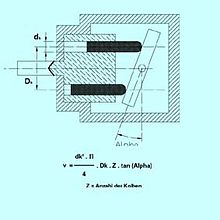Swash plate machine
A swashplate machine is a device that is used in hydraulics as an axial piston pump to convert mechanical energy ( torque , speed ) into hydraulic energy ( volume flow , pressure ) or as an axial piston motor to convert hydraulic energy (volume flow, pressure) into mechanical energy (torque, speed) can be used. According to the system of the hydraulic designer and pioneer Hans Molly , the swash plate machine is also known as the MZ machine .
functionality
Pumps and motors are similar in structure. Like all axial piston machines, the swash plate machine also has a rotating part which is firmly coupled to the drive shaft and which has cylinder bores in which the pistons run. Similar to the bent axis machine, the pistons are supported by articulated bearings on a sliding disk. If the disc is tilted (the position of the disc can be changed on variable displacement machines), the pistons execute a stroke movement when the pump shaft is driven (or the output shaft rotates when pressure is applied to the piston).
The difference to the bent axis machine lies in the fact that the pump shaft and the cylinder housing are always parallel to each other and the position of the disk deviates from this, while with the bent axis machine the sliding disk is always attached planar to the shaft cross section and the cylinder housing is at an angle to the shaft.
See also: axial piston machine
Individual evidence
- ^ Hans Jürgen Matthies , Karl Theodor Renius: Introduction to oil hydraulics. 6th, updated and expanded edition. Vieweg + Teubner, Wiesbaden 2008, ISBN 978-3-8351-0238-5 , p. 71 .
